Reduction of In Vivo Placental Amino Acid Transport Precedes the Development of Intrauterine Growth Restriction in the Non-Human Primate
Abstract
1. Introduction
2. Materials and Methods
2.1. Animal Maintenance
2.2. Feeding
2.3. Composition of Diet
2.4. Experimental Design
2.5. Blood and Tissue Collection
2.6. Stable Isotope-Labeled Essential Amino Acids
2.7. Placental MVM and BM Vesicles Preparation
2.8. System A and System L Amino Acid Transport Activity
2.9. Western Blot Analysis
2.10. Statistical Analysis
3. Results
3.1. Fetal and Placental Weights of Control and MNR Group
3.2. Maternal Enrichment
3.3. Fv/M MPE Ratios
3.4. Effect of MNR on System A and System L Amino Acid Transport Activity in MVM
3.5. Leucine Transport in BM
3.6. Protein Expression of System L Acid Transporter Isoforms in MVM
3.7. Protein Expression of SNAT2 Transporter Isoform in MVM
3.8. Protein Expression of TAUT and GLUT1 Transporter Isoforms in MVM at GD 140
4. Discussion
5. Conclusions
Supplementary Materials
Author Contributions
Funding
Institutional Review Board Statement
Informed Consent Statement
Data Availability Statement
Acknowledgments
Conflicts of Interest
References
- Malhotra, A.; Allison, B.J.; Castillo-Melendez, M.; Jenkin, G.; Polglase, G.R.; Miller, S.L. Neonatal Morbidities of Fetal Growth Restriction: Pathophysiology and Impact. Front Endocrinol. 2019, 10, 55. [Google Scholar] [CrossRef]
- Sharma, D.; Shastri, S.; Farahbakhsh, N.; Sharma, P. Intrauterine growth restriction—Part 1. J. Matern Fetal Neonatal Med. 2016, 29, 3977–3987. [Google Scholar] [CrossRef]
- Brodsky, D.; Christou, H. Current concepts in intrauterine growth restriction. J. Intensive Care Med. 2004, 19, 307–319. [Google Scholar] [CrossRef] [PubMed]
- Gluckman, P.D.; Hanson, M.A.; Cooper, C.; Thornburg, K.L. Effect of in utero and early-life conditions on adult health and disease. N. Engl. J. Med. 2008, 359, 61–73. [Google Scholar] [CrossRef] [PubMed]
- Hales, C.N.; Barker, D.J.; Clark, P.M.; Cox, L.J.; Fall, C.; Osmond, C.; Winter, P.D. Fetal and infant growth and impaired glucose tolerance at age 64. BMJ 1991, 303, 1019–1022. [Google Scholar] [CrossRef] [PubMed]
- Barker, D.J.; Gluckman, P.D.; Godfrey, K.M.; Harding, J.E.; Owens, J.A.; Robinson, J.S. Fetal nutrition and cardiovascular disease in adult life. Lancet 1993, 341, 938–941. [Google Scholar] [CrossRef]
- Sibley, C.P.; Turner, M.A.; Cetin, I.; Ayuk, P.; Boyd, C.A.; D’Souza, S.W.; Glazier, J.D.; Greenwood, S.L.; Jansson, T.; Powell, T. Placental phenotypes of intrauterine growth. Pediatr. Res. 2005, 58, 827–832. [Google Scholar] [CrossRef]
- Nord, M.; Andrews, C.J.; Andrews, M.S.; Carlson, S. Household Food Security in the United States 2009; United States Department of Agriculture, Economic Research Services: Washington, DC, USA, 2020.
- Jansson, N.; Pettersson, J.; Haafiz, A.; Ericsson, A.; Palmberg, I.; Tranberg, M.; Ganapathy, V.; Powell, T.L.; Jansson, T. Down-regulation of placental transport of amino acids precedes the development of intrauterine growth restriction in rats fed a low protein diet. J. Physiol. 2006, 576, 935–946. [Google Scholar]
- Roos, S.; Jansson, N.; Palmberg, I.; Saljo, K.; Powell, T.L.; Jansson, T. Mammalian target of rapamycin in the human placenta regulates leucine transport and is down-regulated in restricted fetal growth. J. Physiol. 2007, 582, 449–459. [Google Scholar] [CrossRef]
- Kavitha, J.V.; Rosario, F.J.; Nijland, M.J.; McDonald, T.J.; Wu, G.; Kanai, Y.; Powell, T.L.; Nathanielsz, P.W.; Jansson, T. Down-regulation of placental mTOR, insulin/IGF-I signaling, and nutrient transporters in response to maternal nutrient restriction in the baboon. FASEB J. 2014, 28, 1294–1305. [Google Scholar] [CrossRef]
- Rosario, F.J.; Jansson, N.; Kanai, Y.; Prasad, P.D.; Powell, T.L.; Jansson, T. Maternal protein restriction in the rat inhibits placental insulin, mTOR, and STAT3 signaling and down-regulates placental amino acid transporters. Endocrinology 2011, 152, 1119–1129. [Google Scholar] [CrossRef] [PubMed]
- Verrey, F. System L: Heteromeric exchangers of large, neutral amino acids involved in directional transport. Pflug. Arch. 2003, 445, 529–533. [Google Scholar] [CrossRef] [PubMed]
- del Amo, E.M.; Urtti, A.; Yliperttula, M. Pharmacokinetic role of L-type amino acid transporters LAT1 and LAT2. Eur. J. Pharm. Sci. 2008, 35, 161–174. [Google Scholar] [CrossRef]
- Gaccioli, F.; Aye, I.L.; Roos, S.; Lager, S.; Ramirez, V.I.; Kanai, Y.; Powell, T.L.; Jansson, T. Expression and functional characterisation of System L amino acid transporters in the human term placenta. Reprod. Biol. Endocrinol. 2015, 13, 57. [Google Scholar] [CrossRef] [PubMed]
- Christensen, H.N.; Oxender, D.L.; Liang, M.; Vatz, K.A. The use of N-methylation to direct route of mediated transport of amino acids. J. Biol. Chem. 1965, 240, 3609–3616. [Google Scholar] [CrossRef]
- Matoba, S.; Nakamuta, S.; Miura, K.; Hirose, M.; Shiura, H.; Kohda, T.; Nakamuta, N.; Ogura, A. Paternal knockout of Slc38a4/SNAT4 causes placental hypoplasia associated with intrauterine growth restriction in mice. Proc. Natl. Acad. Sci. USA 2019, 116, 21047–21053. [Google Scholar] [CrossRef] [PubMed]
- Chen, Y.Y.; Rosario, F.J.; Abu Shehab, M.; Powell, T.L.; Gupta, M.B.; Jansson, T. Increased ubiquitination and reduced plasma membrane trafficking of placental amino acid transporter SNAT-2 in human IUGR. Clin. Sci. 2015, 129, 1131–1141. [Google Scholar] [CrossRef] [PubMed]
- Jansson, T.; Ylven, K.; Wennergren, M.; Powell, T.L. Glucose transport and system A activity in syncytiotrophoblast microvillous and basal plasma membranes in intrauterine growth restriction. Placenta 2002, 23, 392–399. [Google Scholar] [CrossRef]
- Shibata, E.; Hubel, C.A.; Powers, R.W.; von Versen-Hoeynck, F.; Gammill, H.; Rajakumar, A.; Roberts, J.M. Placental system A amino acid transport is reduced in pregnancies with small for gestational age (SGA) infants but not in preeclampsia with SGA infants. Placenta 2008, 29, 879–882. [Google Scholar] [CrossRef]
- Mahendran, D.; Donnai, P.; Glazier, J.D.; D’Souza, S.W.; Boyd, R.D.; Sibley, C.P. Amino acid (system A) transporter activity in microvillous membrane vesicles from the placentas of appropriate and small for gestational age babies. Pediatr. Res. 1993, 34, 661–665. [Google Scholar] [CrossRef]
- Glazier, J.D.; Cetin, I.; Perugino, G.; Ronzoni, S.; Grey, A.M.; Mahendran, D.; Marconi, A.M.; Pardi, G.; Sibley, C.P. Association between the activity of the system A amino acid transporter in the microvillous plasma membrane of the human placenta and severity of fetal compromise in intrauterine growth restriction. Pediatr. Res. 1997, 42, 514–519. [Google Scholar] [CrossRef]
- Mando, C.; Tabano, S.; Pileri, P.; Colapietro, P.; Marino, M.A.; Avagliano, L.; Doi, P.; Bulfamante, G.; Miozzo, M.; Cetin, I. SNAT2 expression and regulation in human growth-restricted placentas. Pediatr. Res. 2013, 74, 104–110. [Google Scholar] [CrossRef] [PubMed]
- Rodriguez, J.S.; Zurcher, N.R.; Keenan, K.E.; Bartlett, T.Q.; Nathanielsz, P.W.; Nijland, M.J. Prenatal betamethasone exposure has sex specific effects in reversal learning and attention in juvenile baboons. Am. J. Obs. Gynecol. 2011, 204, 545-e1. [Google Scholar] [CrossRef] [PubMed]
- Zurcher, N.R.; Rodriguez, J.S.; Jenkins, S.L.; Keenan, K.; Bartlett, T.Q.; McDonald, T.J.; Nathanielsz, P.W.; Nijland, M.J. Performance of juvenile baboons on neuropsychological tests assessing associative learning, motivation and attention. J. Neurosci. Methods 2010, 188, 219–225. [Google Scholar] [CrossRef]
- Nijland, M.J.; Schlabritz-Loutsevitch, N.E.; Hubbard, G.B.; Nathanielsz, P.W.; Cox, L.A. Non-human primate fetal kidney transcriptome analysis indicates mammalian target of rapamycin (mTOR) is a central nutrient-responsive pathway. J. Physiol. 2007, 579, 643–656. [Google Scholar] [CrossRef] [PubMed]
- Kamat, A.; Nijland, M.J.; McDonald, T.J.; Cox, L.A.; Nathanielsz, P.W.; Li, C. Moderate global reduction in maternal nutrition has differential stage of gestation specific effects on {beta}1- and {beta}2-adrenergic receptors in the fetal baboon liver. Reprod. Sci. 2011, 18, 398–405. [Google Scholar] [CrossRef] [PubMed]
- Schlabritz-Loutsevitch, N.E.; Dudley, C.J.; Gomez, J.J.; Nevill, C.H.; Smith, B.K.; Jenkins, S.L.; McDonald, T.J.; Bartlett, T.Q.; Nathanielsz, P.W.; Nijland, M.J. Metabolic adjustments to moderate maternal nutrient restriction. Br. J. Nutr. 2007, 98, 276–284. [Google Scholar] [CrossRef][Green Version]
- Cox, L.A.; Schlabritz-Loutsevitch, N.; Hubbard, G.B.; Nijland, M.J.; McDonald, T.J.; Nathanielsz, P.W. Gene expression profile differences in left and right liver lobes from mid-gestation fetal baboons: A cautionary tale. J. Physiol. 2006, 572, 59–66. [Google Scholar] [CrossRef]
- Nijland, M.J.; Mitsuya, K.; Li, C.; Ford, S.; McDonald, T.J.; Nathanielsz, P.W.; Cox, L.A. Epigenetic modification of fetal baboon hepatic phosphoenolpyruvate carboxykinase following exposure to moderately reduced nutrient availability. J. Physiol. 2010, 588, 1349–1359. [Google Scholar] [CrossRef]
- Cox, L.A.; Nijland, M.J.; Gilbert, J.S.; Schlabritz-Loutsevitch, N.E.; Hubbard, G.B.; McDonald, T.J.; Shade, R.E.; Nathanielsz, P.W. Effect of 30 per cent maternal nutrient restriction from 0.16 to 0.5 gestation on fetal baboon kidney gene expression. J. Physiol. 2006, 572, 67–85. [Google Scholar] [CrossRef]
- Rodriguez, J.S.; Zurcher, N.R.; Bartlett, T.Q.; Nathanielsz, P.W.; Nijland, M.J. CANTAB delayed matching to sample task performance in juvenile baboons. J. Neurosci. Methods 2011, 196, 258–263. [Google Scholar] [CrossRef] [PubMed]
- Antonow-Schlorke, I.; Schwab, M.; Cox, L.A.; Li, C.; Stuchlik, K.; Witte, O.W.; Nathanielsz, P.W.; McDonald, T.J. Vulnerability of the fetal primate brain to moderate reduction in maternal global nutrient availability. Proc. Natl. Acad. Sci. USA 2011, 108, 3011–3016. [Google Scholar] [CrossRef] [PubMed]
- Pantham, P.; Rosario, F.J.; Weintraub, S.T.; Nathanielsz, P.W.; Powell, T.L.; Li, C.; Jansson, T. Down-Regulation of Placental Transport of Amino Acids Precedes the Development of Intrauterine Growth Restriction in Maternal Nutrient Restricted Baboons. Biol. Reprod. 2016, 95, 98. [Google Scholar] [CrossRef]
- Galan, H.L.; Marconi, A.M.; Paolini, C.L.; Cheung, A.; Battaglia, F.C. The transplacental transport of essential amino acids in uncomplicated human pregnancies. Am. J. Obs. Gynecol. 2009, 200, 91.e1–91.e7. [Google Scholar] [CrossRef]
- Illsley, N.P.; Wang, Z.Q.; Gray, A.; Sellers, M.C.; Jacobs, M.M. Simultaneous preparation of paired, syncytial, microvillous and basal membranes from human placenta. Biochim. Biophys. Acta 1990, 1029, 218–226. [Google Scholar] [CrossRef]
- Jansson, T.; Ekstrand, Y.; Bjorn, C.; Wennergren, M.; Powell, T.L. Alterations in the activity of placental amino acid transporters in pregnancies complicated by diabetes. Diabetes 2002, 51, 2214–2219. [Google Scholar] [CrossRef]
- Pantham, P.; Rosario, F.J.; Nijland, M.; Cheung, A.; Nathanielsz, P.W.; Powell, T.L.; Galan, H.L.; Li, C.; Jansson, T. Reduced placental amino acid transport in response to maternal nutrient restriction in the baboon. Am. J. Physiol. Regul. Integr. Comp. Physiol. 2015, 309, R740–R746. [Google Scholar] [CrossRef]
- Van Calsteren, K.; de Catte, L.; Devlieger, R.; Chai, D.C.; Amant, F. Sonographic biometrical normograms and estimation of fetal weight in the baboon (Papio anubis). J. Med. Primatol. 2009, 38, 321–327. [Google Scholar] [CrossRef]
- Ma, Y.; Zhu, M.J.; Uthlaut, A.B.; Nijland, M.J.; Nathanielsz, P.W.; Hess, B.W.; Ford, S.P. Upregulation of growth signaling and nutrient transporters in cotyledons of early to mid-gestational nutrient restricted ewes. Placenta 2011, 32, 255–263. [Google Scholar] [CrossRef]
- Jansson, T.; Scholtbach, V.; Powell, T.L. Placental transport of leucine and lysine is reduced in intrauterine growth restriction. Pediatr. Res. 1998, 44, 532–537. [Google Scholar] [CrossRef]
- Ganapathy, M.E.; Leibach, F.H.; Mahesh, V.B.; Howard, J.C.; Devoe, L.D.; Ganapathy, V. Characterization of tryptophan transport in human placental brush-border membrane vesicles. Biochem. J. 1986, 238, 201–208. [Google Scholar] [CrossRef]
- Kudo, Y.; Boyd, C.A. Characterisation of L-tryptophan transporters in human placenta: A comparison of brush border and basal membrane vesicles. J. Physiol. 2001, 531, 405–416. [Google Scholar] [CrossRef]
- Sano, M.; Ferchaud-Roucher, V.; Kaeffer, B.; Poupeau, G.; Castellano, B.; Darmaun, D. Maternal and fetal tryptophan metabolism in gestating rats: Effects of intrauterine growth restriction. Amino Acids 2016, 48, 281–290. [Google Scholar] [CrossRef]
- Xu, K.; Liu, G.; Fu, C. The Tryptophan Pathway Targeting Antioxidant Capacity in the Placenta. Oxid Med. Cell Longev. 2018, 2018, 1054797. [Google Scholar] [CrossRef]
- Huber, H.F.; Ford, S.M.; Bartlett, T.Q.; Nathanielsz, P.W. Increased aggressive and affiliative display behavior in intrauterine growth restricted baboons. J. Med. Primatol. 2015, 44, 143–157. [Google Scholar] [CrossRef]
- Teodoro, G.F.; Vianna, D.; Torres-Leal, F.L.; Pantaleao, L.C.; Matos-Neto, E.M.; Donato, J., Jr.; Tirapegui, J. Leucine is essential for attenuating fetal growth restriction caused by a protein-restricted diet in rats. J. Nutr. 2012, 142, 924–930. [Google Scholar] [CrossRef] [PubMed]
- Gaccioli, F.; Lager, S.; Powell, T.L.; Jansson, T. Placental transport in response to altered maternal nutrition. J. Dev. Orig. Health Dis. 2013, 4, 101–115. [Google Scholar] [CrossRef]
- Rosso, P. Maternal-fetal exchange during protein malnutrition in the rat. Placental transfer of glucose and a nonmetabolizable glucose analog. J. Nutr. 1977, 107, 20006–20010. [Google Scholar] [CrossRef] [PubMed]
- Rosso, P. Maternal-fetal exchange during protein malnutrition in the rat. Placental transfer of alpha-amino isobutyric acid. J. Nutr. 1977, 107, 2002–2005. [Google Scholar] [CrossRef] [PubMed]
- Rosso, P. Maternal malnutrition and placental transfer of alpha-aminoisobutyric acid in the rat. Science 1975, 187, 648–650. [Google Scholar] [CrossRef]
- Varma, D.R.; Ramakrishnan, R. Effects of protein-calorie malnutrition on transplacental kinetics of aminoisobutyric acid in rats. Placenta 1991, 12, 277–284. [Google Scholar] [CrossRef]
- Sferruzzi-Perri, A.N.; Vaughan, O.R.; Coan, P.M.; Suciu, M.C.; Darbyshire, R.; Constancia, M.; Burton, G.J.; Fowden, A.L. Placental-specific Igf2 deficiency alters developmental adaptations to undernutrition in mice. Endocrinology 2011, 152, 3202–3212. [Google Scholar] [CrossRef] [PubMed]
- Coan, P.M.; Vaughan, O.R.; Sekita, Y.; Finn, S.L.; Burton, G.J.; Constancia, M.; Fowden, A.L. Adaptations in placental phenotype support fetal growth during undernutrition of pregnant mice. J. Physiol. 2010, 588, 527–538. [Google Scholar] [CrossRef] [PubMed]
- Coan, P.M.; Vaughan, O.R.; McCarthy, J.; Mactier, C.; Burton, G.J.; Constancia, M.; Fowden, A.L. Dietary composition programmes placental phenotype in mice. J. Physiol. 2011, 589, 3659–3670. [Google Scholar] [CrossRef] [PubMed]
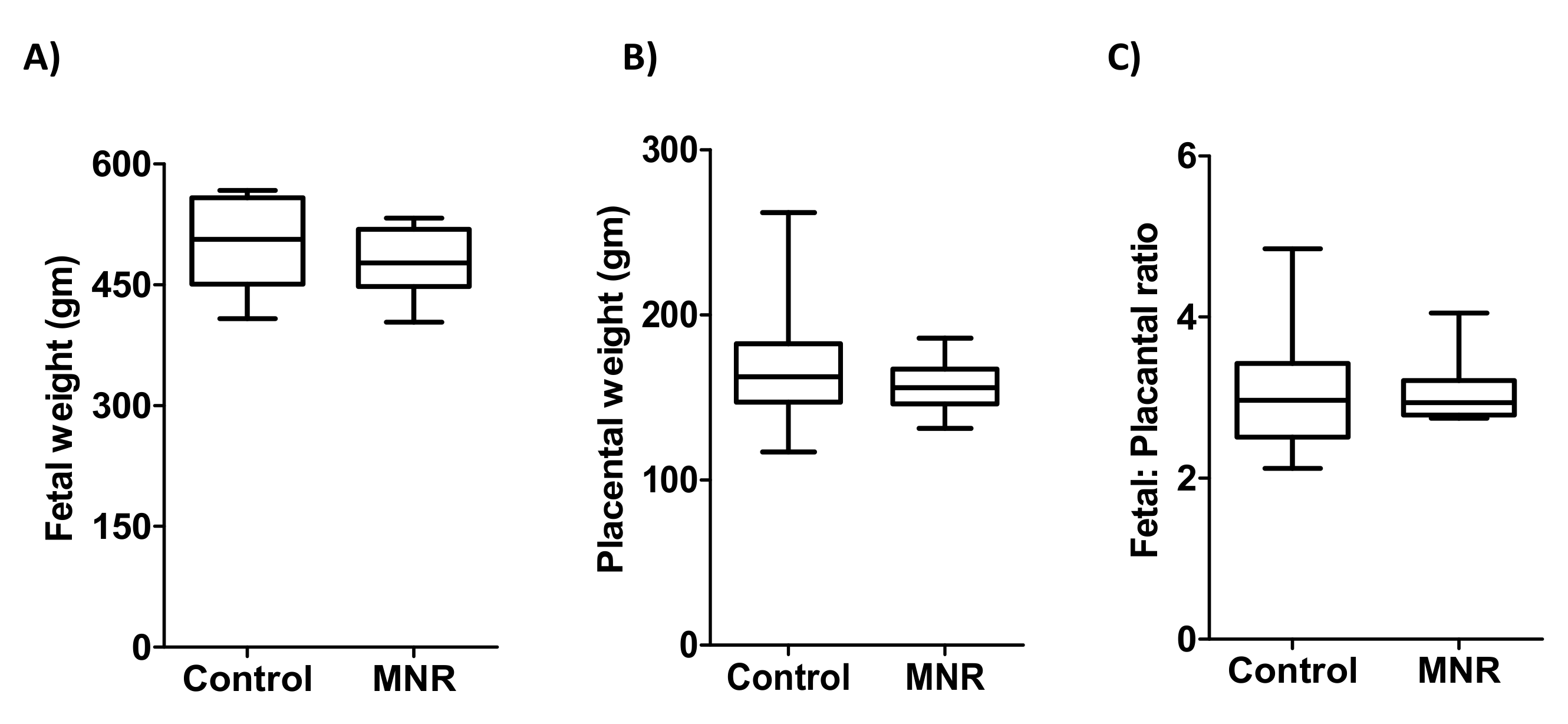


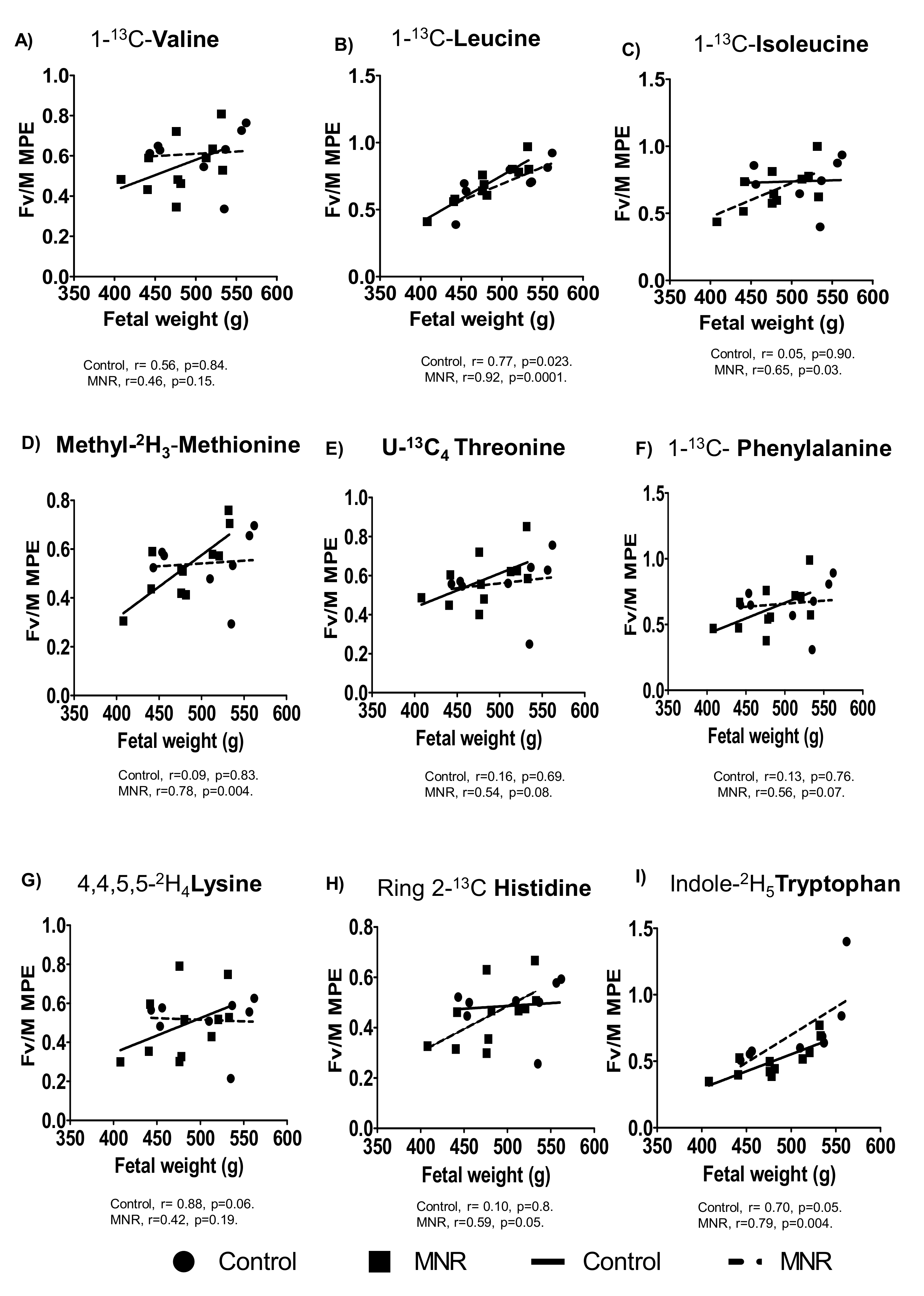


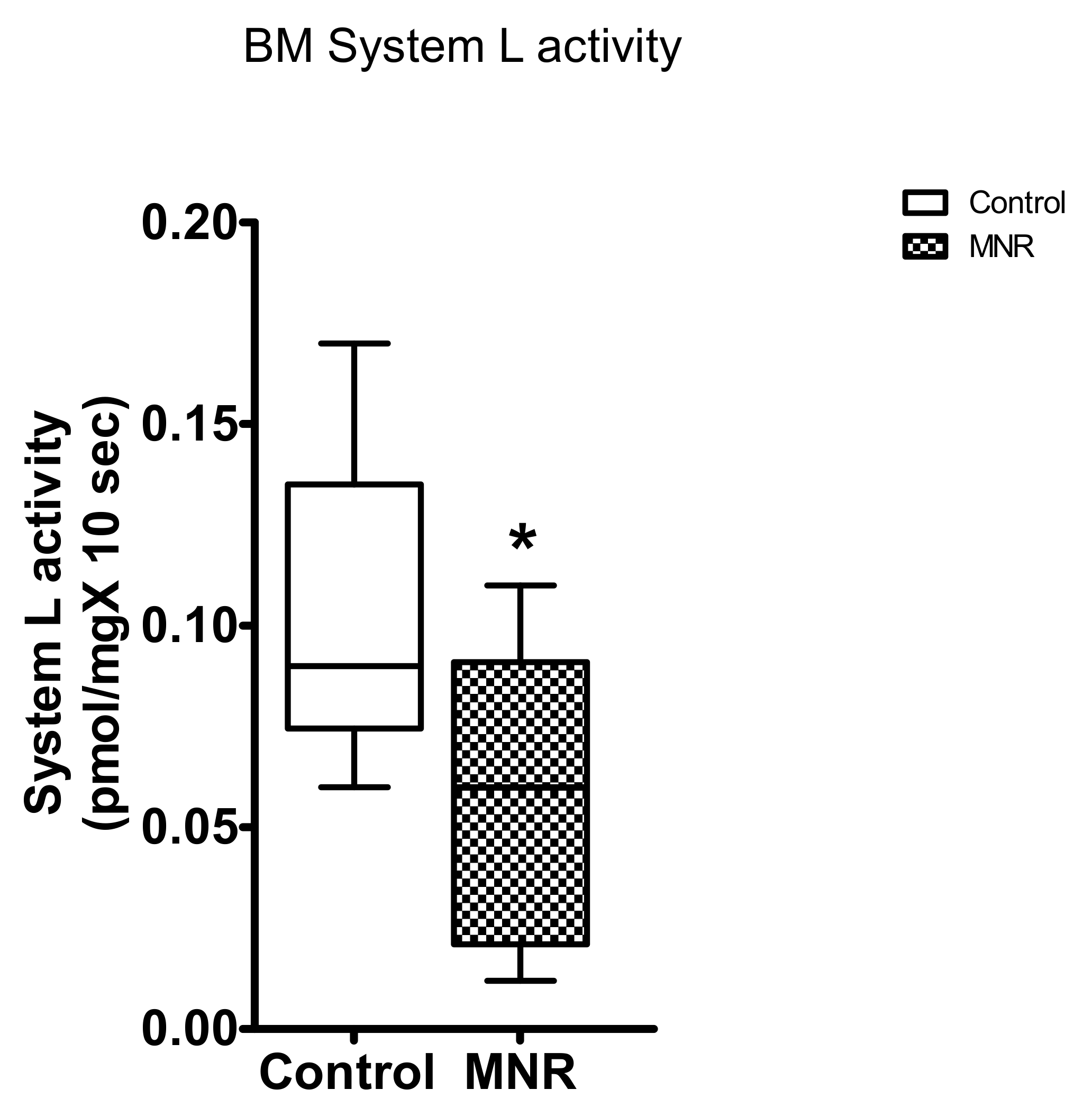
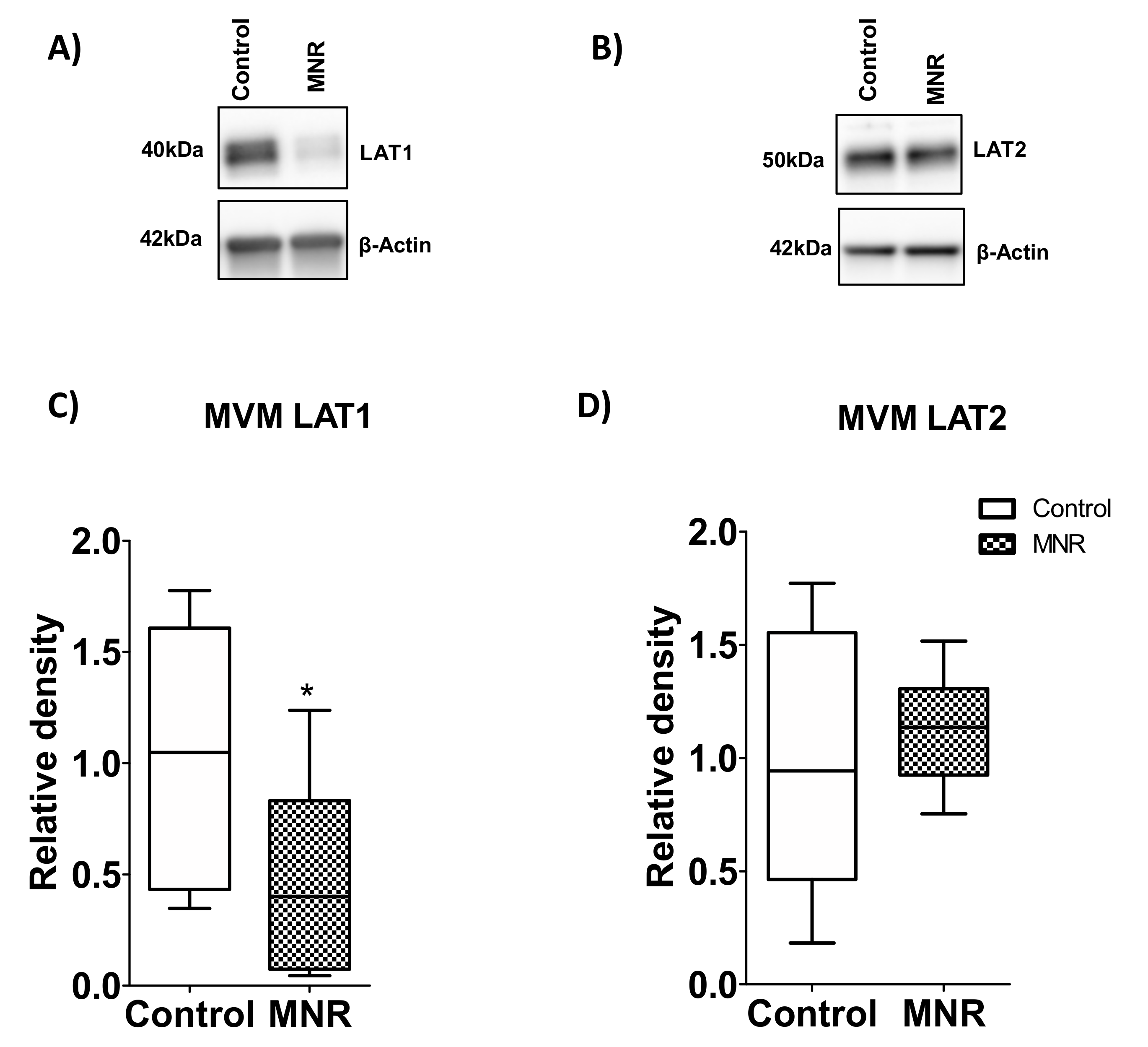
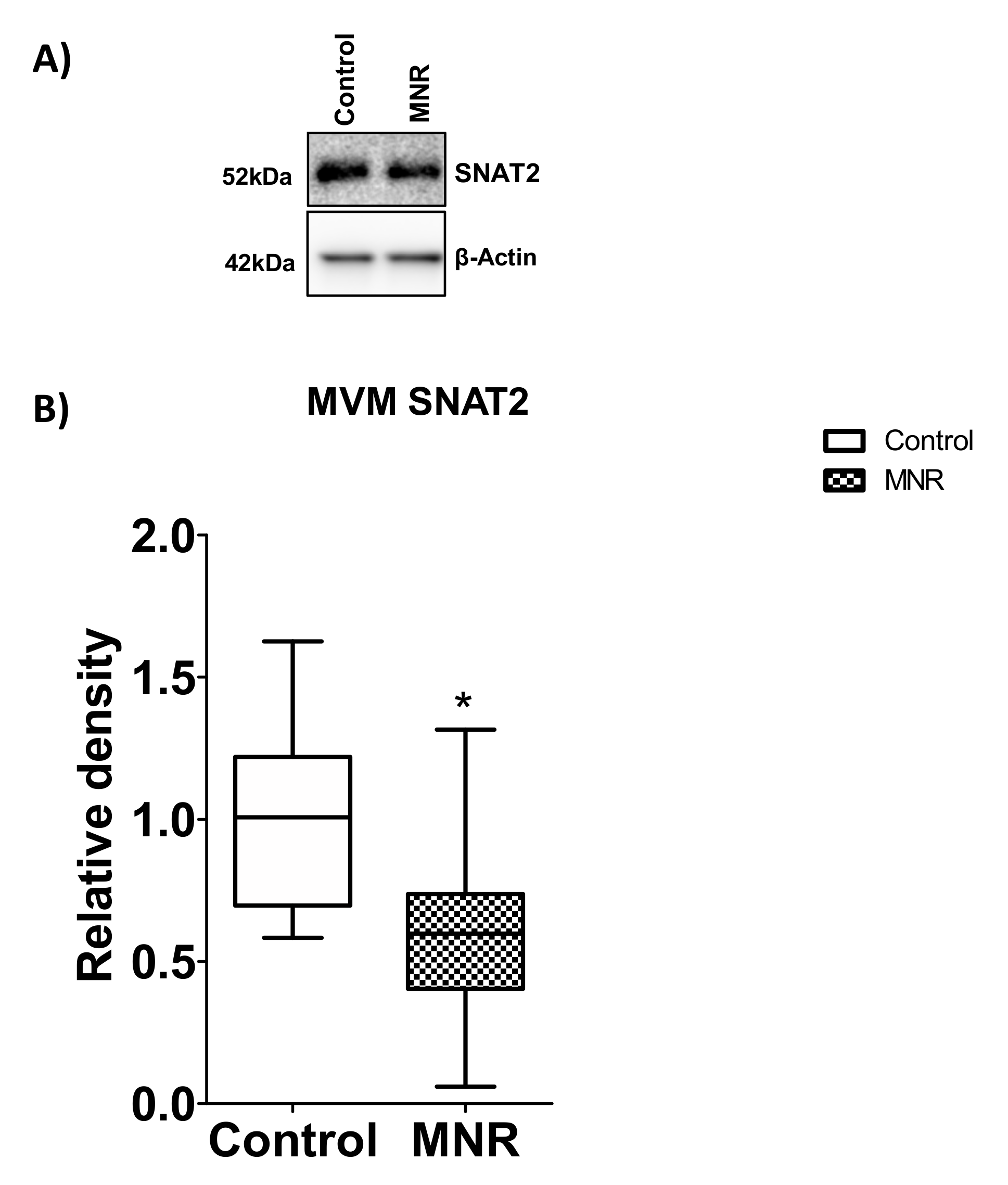
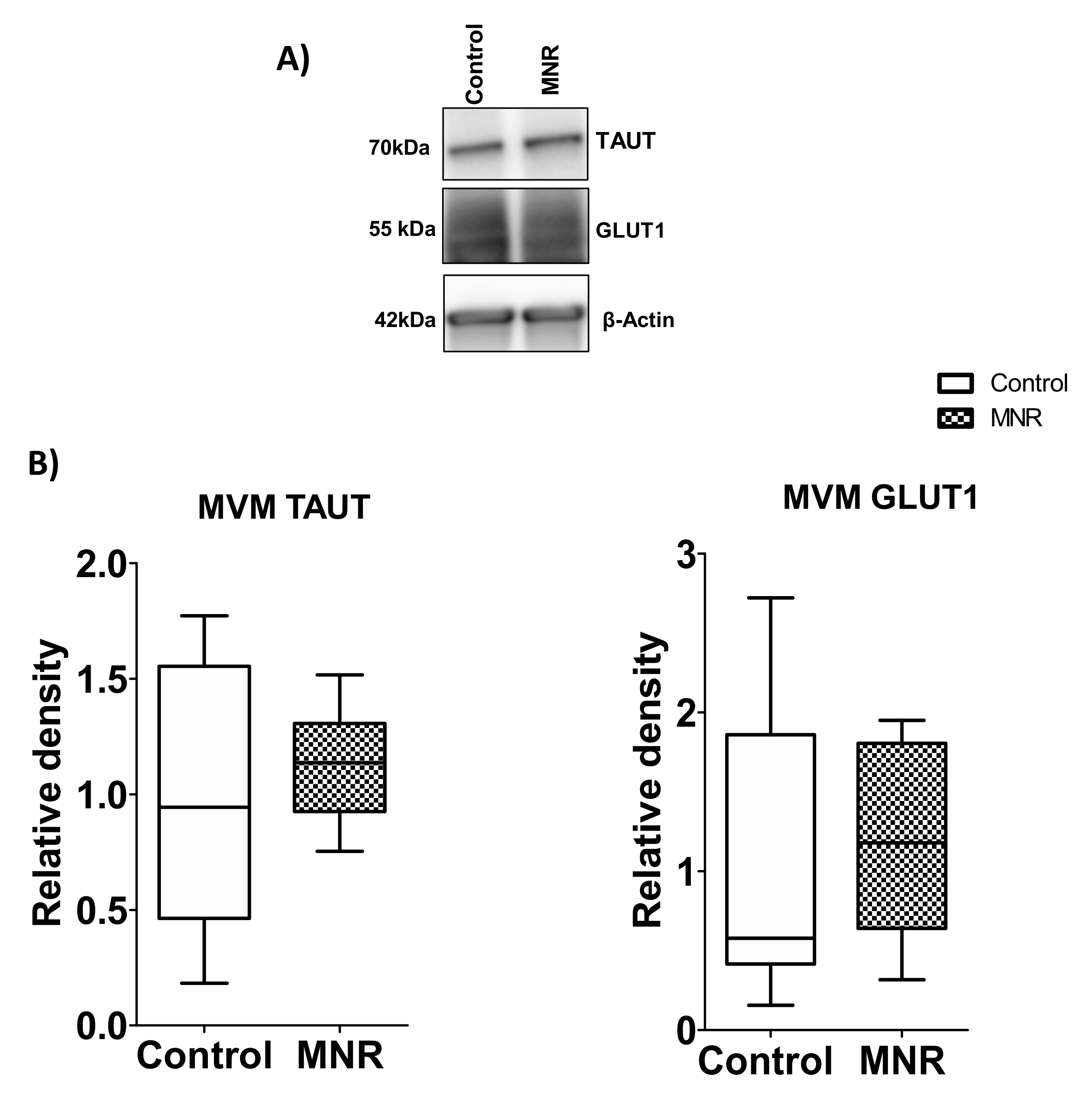

| Amino Acid | Isotopic Labelling | Concentration of Amino Acid (mg/mL) | Molar Concentration |
|---|---|---|---|
| Valine | (1-13C) | 1.25 | 0.01 |
| Leucine | (1-13C) | 1.25 | 0.009 |
| Isoleucine | (1-13C) | 1.25 | 0.009 |
| Methionine | [Methyl-2H3] | 1.25 | 0.008 |
| Threonine | [U-13C4] | 2.5 | 0.02 |
| Phenylalanine | [1-13C] | 1.25 | 0.007 |
| Lysine | [4,4,5,5-2H4] | 2.5 | 0.011 |
| Histidine | [Ring 2-13C] | 2.5 | 0.012 |
| Tryptophan | [Indole-2H5] | 2.5 | 0.012 |
| Parameters | Gestation Day 120 | Gestation Day 140 | Gestation Day 165 |
|---|---|---|---|
| Reference | [34] | Current study | [11,38] |
| Fetal weight | ⬌ | ⬌ | ↓ |
| Placental weight | ⬌ | ⬌ | ↓ |
| MVM System A activity | ↓ | ↓ | ↓ |
| MVM System A amino acid transporter isoforms (SNAT1,2 and 4) expression | ⬌ | ↓SNAT2 | ↓SNAT2; ⬌ SNAT1, SNAT4 |
| MVM System L activity | ⬌ | ↓ | ↓ |
| MVM System L amino acid transporter isoforms expression (LAT1 and 2) | ⬌ | ↓LAT1 | ↓LAT1 and LAT2 |
| MVM Taurine transporter expression | ⬌ | ⬌ | ↓ |
| BM System L activity | ⬌ | ↓ | ↓ |
| BM System L amino acid transporter LAT1 isoform expression | ⬌ | Not studied | Not studied |
| Maternal plasma concentration of amino acids | ⬌ | Not studied | ↓Aspartic acid, glutamic acid, tyrosine, tryptophan, phenylalanine, leucine, and ornithine; ↑Glycine |
| Fetal plasma concentration of amino acids | ↓ Leucine and isoleucine. ↑Citrulline | Not studied | ↓Taurine, tyrosine, phenylalanine, leucine, and ornithine |
| In vivo transplacental amino acid transport | Not studied | ↓Tryptophan | ↓Leucine, isoleucine, methionine, phenylalanine, threonine, and tryptophan |
Publisher’s Note: MDPI stays neutral with regard to jurisdictional claims in published maps and institutional affiliations. |
© 2021 by the authors. Licensee MDPI, Basel, Switzerland. This article is an open access article distributed under the terms and conditions of the Creative Commons Attribution (CC BY) license (https://creativecommons.org/licenses/by/4.0/).
Share and Cite
Rosario, F.J.; Kramer, A.; Li, C.; Galan, H.L.; Powell, T.L.; Nathanielsz, P.W.; Jansson, T. Reduction of In Vivo Placental Amino Acid Transport Precedes the Development of Intrauterine Growth Restriction in the Non-Human Primate. Nutrients 2021, 13, 2892. https://doi.org/10.3390/nu13082892
Rosario FJ, Kramer A, Li C, Galan HL, Powell TL, Nathanielsz PW, Jansson T. Reduction of In Vivo Placental Amino Acid Transport Precedes the Development of Intrauterine Growth Restriction in the Non-Human Primate. Nutrients. 2021; 13(8):2892. https://doi.org/10.3390/nu13082892
Chicago/Turabian StyleRosario, Fredrick J., Anita Kramer, Cun Li, Henry L. Galan, Theresa L. Powell, Peter W. Nathanielsz, and Thomas Jansson. 2021. "Reduction of In Vivo Placental Amino Acid Transport Precedes the Development of Intrauterine Growth Restriction in the Non-Human Primate" Nutrients 13, no. 8: 2892. https://doi.org/10.3390/nu13082892
APA StyleRosario, F. J., Kramer, A., Li, C., Galan, H. L., Powell, T. L., Nathanielsz, P. W., & Jansson, T. (2021). Reduction of In Vivo Placental Amino Acid Transport Precedes the Development of Intrauterine Growth Restriction in the Non-Human Primate. Nutrients, 13(8), 2892. https://doi.org/10.3390/nu13082892






